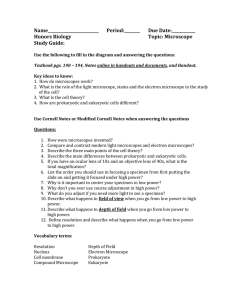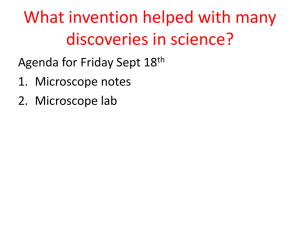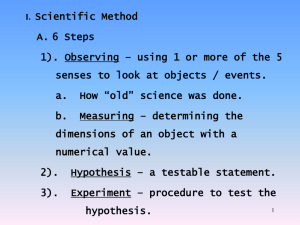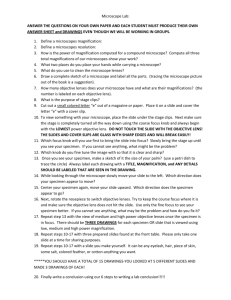Foundations of biology
advertisement
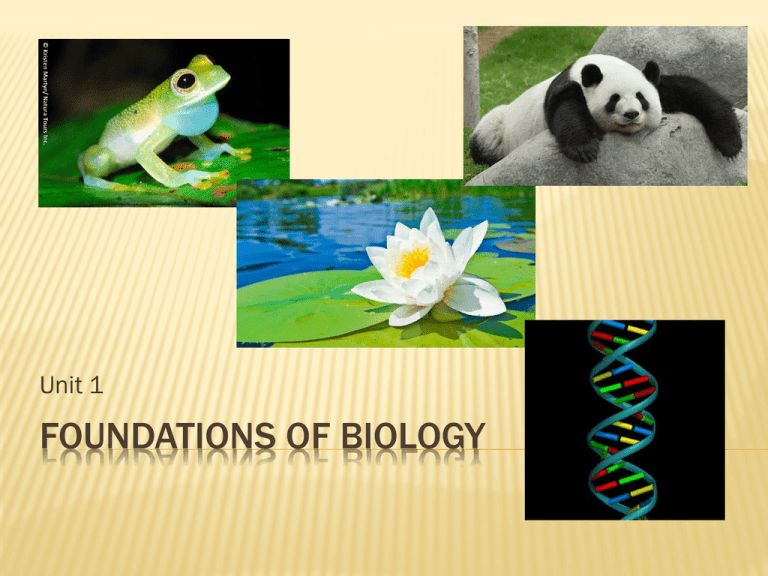
Unit 1 FOUNDATIONS OF BIOLOGY Chapter 1 THE SCIENCE OF LIFE SECTION 1 THE WORLD OF BIOLOGY Objectives Relate biology to everyday life Describe importance of biology List characteristics of living things Summarize hierarchy of organization Distinguish between homeostasis & metabolism, growth, development & reproduction SECTION 1 Vocabulary Biology Organization Cell Unicellular Multicellular Organ tissue Organelle Vocabulary Biological molecule Homeostasis Metabolism Cell division Development Reproduction Gene BIOLOGY AND YOU Biology: study of life Organized and scientific framework to answer questions about natural world Biologist: studies how living things work, interact with environment and change over time Example: healthy foods, exercise, avoid getting sick CHARACTERISTICS OF LIFE Name 5 living and 5 non-living things Criteria for living: 7 Characteristics Organization (1 or more cells) Response to stimulus Homeostasis Metabolism Growth & development Reproduction Change over time 1. 2. 3. 4. 5. 6. 7. 1. ORGANIZATION AND CELLS High degree of order within internal & external parts. Unicellular: organism made of one cell. Example? Multicellular: organism made of multiple cells Example? 1. ORGANIZATION AND CELLS Highest level of organization have organ systems: group of specialized parts that carry out a specific function. Organs: structures that carry out specialized jobs. Made of tissues. Tissues: groups of cells that have similar abilities and follows the organ function. Made of cells Cells: covered by membrane, contains all genetic information. Has organelles Organelles: tiny structures that help cell stay alive. Contain biological molecules. Biological molecules: Chemical compounds. Made of atoms Atoms: simplest particle of an element 2. RESPONSE TO STIMULI Stimulus: physical/chemical change in internal/external environment. Respond and react to changes Example: stimulus: bright light. Reaction? https://www.youtube.com/watch?v=h6evXswaQs 3. HOMEOSTASIS Maintain stable internal conditions Example: temperature, water content, nutrient uptake. How do humans control body temperature? 4. METABOLISM Sum of all the chemical reactions that take in and transform energy and materials from the environment. Example: plants: photosynthesis. Mammals: ingest and digest food. 5. GROWTH AND DEVELOPMENT Increase in size by dividing and enlarging cells. Crystals grow by accumulating more cells, not by division and enlargement Cell division: forming of two new cells from an existing cell Development: process of maturation. Involves cell division and differentiation. And specialization 6. REPRODUCTION Produce new organisms Not essential to survival of individual? Why is it important? Continuation of spp Pass on DNA, contains genes Sexual reproduction: recombines two organisms of same spp Asexual reproduction: no combination, identical offspring 7. CHANGE OVER TIME Evolution Organisms change and adapt over time because the environment changes. HOMEWORK SECTION 1 SECTION 2 THEMES IN BIOLOGY Objectives Identify three important themes that help explain the living world Explain how life can be diverse, yet unified Summarize why evolution is an important theme in biology SECTION 2 Vocabulary Domain Kingdom Ecology Ecosystem Evolution Natural selection Adaptation DIVERSITY AND UNITY OF LIFE _________________spp on Earth Many more remain to be identified UNITY IN DIVERSITY OF LIFE Themes: 1. ___________________________ 2. ___________________________ 3. ___________________________ Represented by __________________ Model of relationships Similar sets of genes on ___________branches TREE OF LIFE THREE DOMAINS OF LIFE Domains: ______________________________ Kingdoms: Bacteria: ________________ Archaea: ___________________ Eukarya: _______________________________ INTERDEPENDENCE OF ORGANISMS Ecology: ________________________________ _______________________________________ Ecosystems: ____________________________ _______________________________________ Orgs depend on: _________________________ ________________________________________ EVOLUTION OF LIFE Descent with modification, inherited characteristics within a population changes so new spp can develop. Explains ________________________________ _______________________________________. Explains ________________________________ ________________________________________ Explains ________________________________ ________________________________________ NATURAL SELECTION Orgs with favourable traits are better able to ____________and _______________ Adaptations: traits that improve an individuals ability to ___________and _____________. HOMEWORK SECTION 2 SECTION 3 THE STUDY OF BIOLOGY Objectives Outline the main steps in the scientific method Summarize how observations are used to form hypotheses List the elements of a controlled experiment Describe how scientists use data to draw conclusions Compare a scientific hypothesis and a scientific theory State how communication in science helps prevent dishonesty and bias SECTION 3 Vocabulary Scientific method Observation Hypothesis Prediction Experiment Control group Vocabulary Experimental group Independent variable Dependent variable Theory Peer review SCIENCE AS A PROCESS Scientific method: two important principles. 1.______________________________________ ________________________________________ Example: lightning: not from Zues but from electric charges in atmosphere 2. Uniformity: ___________________________ _______________________________________. Example: ________________ STEPS OF THE SCIENTIFIC METHOD 1. Observation: ____________________________ __________________________________________ 2. Hypothesis: ______________________________ 3. Prediction: _______________________________ __________________________________________ 4. Experiment: ______________________________ 5. Analysis: ________________________________ 6. Conclusion & Communication: arrive at a judgment or opinion by ______________, communicate results to ______________________ 1. OBSERVING AND ASKING QUESTIONS Owls capture prey in the ___________ How does an owl detect prey in the dark? 2. FORMING A HYPOTHESIS ________________ A)_______________ B)___________________ C)______________________ 3. PREDICTING ___________________________________ A) the owl will pounce in either a __________or ____________room B) light room: ____________________________ dark room: ______________________________ ________________________________________ C) _____________________________________ ________________________________________ 4. DESIGNING AN EXPERIMENT Set up room with owl perch high on one side, trap door on other side. ________________________________________ Mouse ran silently, leaf made noise Half of trials in light room, half of trials in dark room _________________________________ View tape, measure position of owls strike PERFORMING THE EXPERIMENT Controlled experiment: compares ______________ ________ and _______________, only one variable Control group: normal standard against which comparisons form EG can be made Experimental group: identical to CG except for _______________________________. Experimenter _______________________________ (Owl experiment: presence/absence of light) CG: light, EG: dark _____________________variable: respond variable (Owl experiment: distance of strike from head) TESTING THE EXPERIMENT “Blind experiments”: ______________________ ________________________________________ Eliminates _____________ Repeat experiments for ____________________________________ 5. COLLECTING AND ANALYZING DATA Dependent variable gives quantitative data: _____________________________________ (Owl experiment: distance of strike from head in cm) Scientists use and extend senses: ___________ _____________________ ANALYZING AND COMPARING DATA Organize data Goal: ______________________________, support/fail to support hypothesis Statistics to help determine relationships Compare with other data _______________________________________ _______________________________________ DISTANCE BETWEEN OWL STRIKE & MOUSE/ OWL STRIKE AND LEAF 25 20 15 10 5 0 In light in dark Mouse Leaf 6. DRAWING CONCLUSIONS Light: greater accuracy at __________________ Dark: greater accuracy at __________________ Support _____________hypothesis, not vision hypothesis Experiments only ______________ Can’t ________hearing, maybe unknown smell Only ____________vision hypothesis More experimentation ____________________ ________________________________ MAKING INFERENCES Conclusion made on the basis of _________ and _______________________rather than direct observation Not directly testable Owl study: inferred that owl detects prey from distance, not direct touch APPLYING RESULTS AND BUILDING MODELS __________________________________ Build models to ____________or __________things 1953 James Watson & Francis Crick use cardboard and metal balls to build models of ______________ Mathematical models are __________________ CONSTRUCTING A THEORY Theory according to scientists: _____________, __________________principle that explains observations and experimental data. Theory according to people: _______________, “It’s just a theory” COMMUNICATING IDEAS Publishing findings in ________________ ______________ To _______________or _____________on topic PUBLISHING A PAPER Research paper has four sections _____________________ ______________________ ____________________ _________________ Peer review: experts anonymously read and critique papers Prevents ________________ HONESTY AND BIAS Prevent _____________________and ________ Repeat experiments CONFLICT OF INTEREST Good reputation is invaluable Avoid ____________________________ Example: owner of drug company should not test drug’s safety and effectiveness Research group/__________________will test it __________________will keep scientists honest HOMEWORK SECTION 3 SECTION 4 TOOLS AND TECHNIQUES Objectives List the function of each of the major parts of a compound light microscope Compare two kinds of electron microscopes Describe the importance of having the SI system of measurement State some examples of good lab practice SECTION 4 Vocabulary Compound light microscope Eyepiece (ocular lens) Objective lens Stage Light source magnification Vocabulary Nosepiece Resolution Scanning electron microscope Transmission electron microscope Metric system Base unit MICROSCOPES AS TOOLS Tools are objects used to __________________ of a task Microscopes extend human vision ___________ ___________________ Study __________________________________ LIGHT MICROSCOPES Compound light microscope: shines light _____________a specimen, has _______lenses to magnify images. Mount the specimen on a ________________ Specimen must be ____________ LIGHT MICROSCOPES 4 major parts 1. _________(_________): magnifies ___ times 2. ___________lens: light passes through specimen then through lens. Magnifies the image. Specimens can be stained 3. ______: platform that supports a slide holding specimen 4. Light source: __________________________ MAGNIFICATION AND RESOLUTION Magnification: ___________________________ _________________________ Nosepiece: ______________________________ most powerful objective lens 100× Power of magnification = ________________________________________ MAGNIFICATION AND RESOLUTION Resolution: ______________________________ 2000× magnification image becomes _______ because of light’s properties ___________________________ ELECTRON MICROSCOPES Beam of ________produces an enlarged image __________________________ Some even show contours of _____________ Images in black and white, use computers to add colour Specimen in vacuum chamber, ________________________________________ SCANNING ELECTRON MICROSCOPE (SEM) Beam of electrons _______specimen’s surface 3D images of specimen’s ______________ Specimen sprayed with fine __________coating Beam of electrons aimed at specimen Metal coating emits shower of electrons Electrons project onto fluorescent screen Image of ________________ ______________× magnification TRANSMISSION ELECTRON MICROSCOPE (TEM) Beam of electrons ______________thinly sliced specimen Magnetic lenses _________and _________ image on screen Great resolution ____________× magnification UNITS OF MEASUREMENT Common measurement system to compare results, _______________________________ _____________________________ Decimal system based on _________________ Official name: Système International d’Unités. French ___________________________________(SI) BASE AND OTHER UNITS _____ fundamental base units (Table below) Multiples of base units designated by ________ (table below) Derived units produced by _________________ relationships between 2base units/2derived units (Table below) SI BASE UNITS SAFETY Hazards: chemical, physical, radiological, biological. Examples? GOOD LAB PRACTICE Safe, common-sense habits Never work alone in a lab Safety symbols:


